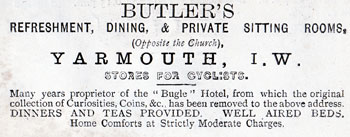YARMOUTH
Having started the eastward journey along the north side of the Island, we pass Warden Point, Colwell Bay, Cliff End, Sconce Point, Black Rock, and Norton Lodge on the shore, and Morton Green and Norton slightly inland, reaching the ancient town of Yarmouth. It is a coupe of miles by train from Freshwater, and is situated at the mouth of the river Yar, which at this point is spanned by a bridge, it has a pier for steamboat and pleasure purposes, and is four miles from Lymington on the mainland, with regular daily steamboat service throughout the year. Yarmouth is governed by Town Commissioners, but it was an old borough town, its powers being abolished by the Act of 1881. Yarmouth for hundreds of years sent two members to Parliament, but this power disappeared when the Reform Act was passed. The Parish Church of St. James was built in 1614. It contains a fine monument to Sir Robert Holmes, Governor of the Island from 1667 to 1692. Charles II. visited him at Yarmouth Castle in 1671 and again in 1675. The statue erected to him was seized in a ship going to France. It was to have been erected in honour of Louis XLV. The body was already sculptured, and the sculptor was on hoard. Holmes compelled him to chisel his head on the statue, so that we have Holmes’s head and Louis XLV’s body. The inscription, translated, is as follows : " Here lies interred Sir Robert Holmes, warrior, the third son of Henry Holmes, of Mallow, in the county of Cork, Ireland. From his youth he was given to military glory, and therefore entered the army. On his first setting out he fought under the banners of his Most Serene Majesty King Charles I. valiantly and successfully against the common enemy. Afterwards, with equal courage amid renown, he engaged in actions at sea, and greatly distinguished himself under the command of the most valiant Prince Rupert, but when he found the Royal cause could no longer be defended by his services he withdrew, and went to aid foreign princes in France, Germany, and Flanders, and became famous for warlike actions. At length, at the restoration of King Charles II,, he was created by him Captain of Sandown Castle, and as a reward for his former merit and courage afterwards knighted. In the year 1666, being constituted Vice-Admiral of the Red, he entered the Dutch fort of Uly with a small fleet, and having there burnt 180 ships, he sailed to Schelling and destroyed I3radderium by fire, the chief town in that Island. For these and several noble exploits, his Serene Majesty honoured him with just rewards for his valour and loyalty—made him Captain-Governor of the Isle of Wight during his life; moreover, lie ordered that the English Lion should be added to the arms of his ancestors, and also for his crest a mailed arm, extended from a naval crown, bearing a trident. These honours, which this valiant man acquired by merit, he defended by his virtue, patriotism, and faithfulness to his king. Sir Robert Holmes died November 18th, 1692."
The Wesleyan Chapel, a handsome new building, is capable of seating 250 persons. The Baptists have a chapel here, with accommodation for 100; and the Bible Christian Chapel can seat 120 worshipers, while the Brethren meet in a room large enough for 50.
The George Hotel contains the rooms occupied by Charles I. when on his way from Carisbrooke to London, November 30th, 1648
To see the Castle the visitor will have to enquire for the Master Gunner, who will show it with pleasure.
The Clepsydra, or hour glass, and many other curiosities may be seen at Mr Butler’s, Yarmouth, where the keys of the Church may be obtained. Mr Butler is also the happy possessor of a Black Letter Bible of the reign of James, 1613, a great curiosity.
Yarmouth has seen troublous times, having on several occasions been attacked by French marauders, and the inhabitants have had to fight for their lives and homes.
Letters arrive for delivery at 7 and 10 a.m. and 1 p.m. Sundays at 7 a.m. Dispatched at noon and 6.15 p.m. Sundays at 6.15 p.m. " {Shalfleet}

The Minerva Isle of Wight Pictorial and Guide - circa 1900
